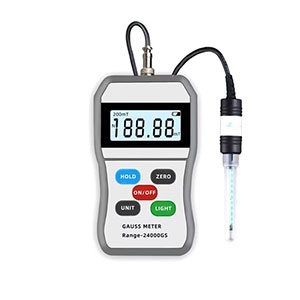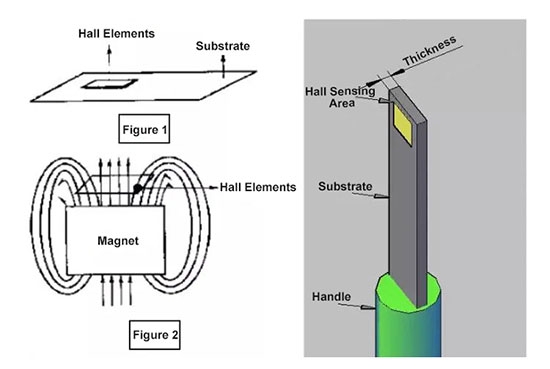Gaussmeter (also called Teslameter or Electromagnetic Field Detector) consists of Hall probe and measuring instrument. Hall probe generates Hall voltage due to Hall effect in magnetic field. After measuring Hall voltage, the magnitude of magnetic induction intensity can be determined according to Hall voltage formula and known Hall coefficient. Teslameter reading is in Gauss or Kilogauss. This article SISCO will briefly introduce the functions, operating principle, classifications and applications of gauss meter to help users have a better understanding of them.
Features of Gauss Meter

- High-precision measurement: Gauss meters can accurately measure magnetic field strength, usually ranging from a few microteslas to thousands of gausses, and are suitable for measuring a variety of magnetic field strengths.
- Strong portability: Many gauss meters are designed as handheld devices, which are lightweight and easy to carry, suitable for mobile measurements in the field and laboratory.
- Digital display: Modern gauss meters are usually equipped with a digital display that can display measurement data in real time, is easy to read, and has high accuracy.
- Multiple measurement units: Gauss meters usually support multiple unit displays, such as Gauss (G) and Tesla (T), which allows users to select the appropriate unit for measurement according to their needs.
- Polarity identification: Gaussmeters can identify the polarity of a magnetic field, helping the user determine the direction of the field (North Pole or South Pole).
- Wide frequency response: Gaussmeter can measure static (DC) magnetic field and dynamic (AC) magnetic field, which is suitable for magnetic field measurement needs in different application scenarios.
- Data storage and transmission: Many gauss meters are equipped with data storage functions to record measurement data. Some also support connection to computers or other devices for data transmission and further analysis.
- A variety of probes are available: According to different application scenarios, the Gaussmeter can be equipped with different types of probes, such as single-axis probes and three-axis probes, to facilitate the measurement of magnetic fields in different directions.
- Automatic calibration function: Some gauss meters have an automatic calibration function to ensure that the device maintains high-precision measurements during use and reduce errors caused by manual calibration.
- Easy to use: Gaussmeters are easy to operate, usually requiring only a simple button operation to start measuring, making them easy to use even for non-professionals.
Gauss Meter Principle
Electromagnetic field detector is an instrument used to measure the strength of a magnetic field. It was invented by German scientist Carl Friedrich Gauss, hence the name. The gaussmeter is based on the combination of a magnetic induction coil and the Hall effect, and the strength of the magnetic field is determined by measuring the voltage generated by the magnetic field on the induction coil.
The magnetic induction coil is the core component of the Gauss meter. It consists of a wire wound on a non-magnetic chip. When the induction coil is placed in a magnetic field, the magnetic field causes the free electrons in the coil to be affected by the Lorentz force, thereby generating a voltage at both ends of the wire. The magnitude of this voltage is proportional to the strength of the magnetic field, so the strength of the magnetic field can be determined by measuring the voltage.
In magnetic induction coils, the Hall effect also plays an important role. The Hall effect refers to the fact that when a conductive material is in a magnetic field and the direction of the current is perpendicular to the magnetic field, a potential difference will be generated on both sides of the conductive material. This potential difference is related to the strength of the magnetic field, the magnitude of the current and the characteristics of the conductive material. The gauss meter uses the Hall effect to measure the strength of the magnetic field more accurately because it can eliminate some errors caused by uneven magnetic fields or inconsistent resistivity of the coil itself.
In addition to the magnetic induction coil and the Hall effect, the gauss meter also requires some auxiliary components to ensure the accuracy of the measurement. For example, the temperature sensor can be used to correct the influence of the coil temperature on the measurement results, the amplifier can amplify the weak signal generated by the coil, and the digital converter can convert the analog signal into a digital signal for processing. The role of these auxiliary components is to improve the measurement accuracy and stability of the gaussmeter.
Application Areas of Gauss Meter
- Magnetic field measurement: Gaussmeter can accurately measure the magnetic field strength generated by magnets, magnetic field coils, permanent magnets, electronic devices, etc. It is usually used for accurate measurement and calibration of magnetic fields in laboratories, factories and research institutions.
- Industrial applications: In the industrial field, gauss meters are used to detect the magnetic field distribution and strength of motors, generators, transformers and other electrical equipment. This helps to evaluate the performance of the equipment and ensure its safety.
- Electronic equipment testing: During the development and production of electronic products, Gauss meters can be used to test the level of electromagnetic radiation in products to avoid electromagnetic interference (EMI) affecting other devices.
- Magnetic field shielding check: In some application scenarios, it is necessary to ensure that the equipment or site is protected from interference from external magnetic fields. Gaussmeters can be used to detect the effectiveness of shielding.
- Medical field: Gauss meters are also used in medical equipment, such as for magnetic field calibration and safety assessment of magnetic resonance imaging (MRI) equipment.
- Education and research: In the teaching and research activities of physics and electromagnetism, gaussmeters are used in experiments and theoretical research to help students and researchers better understand the characteristics of magnetic fields.
In short, the electromagnetic field detector is an instrument that uses magnetic induction coils and the Hall effect to measure the strength of the magnetic field. Its principle is simple and precise, and a series of auxiliary components can improve the accuracy of the measurement. Gaussmeters are widely used in geological exploration, magnetic recording, medical imaging and other fields, providing important help for human life and scientific research. With the development of science and technology, the principle of gauss meter is also constantly being improved and applied. I believe it will show its important role in more fields.

